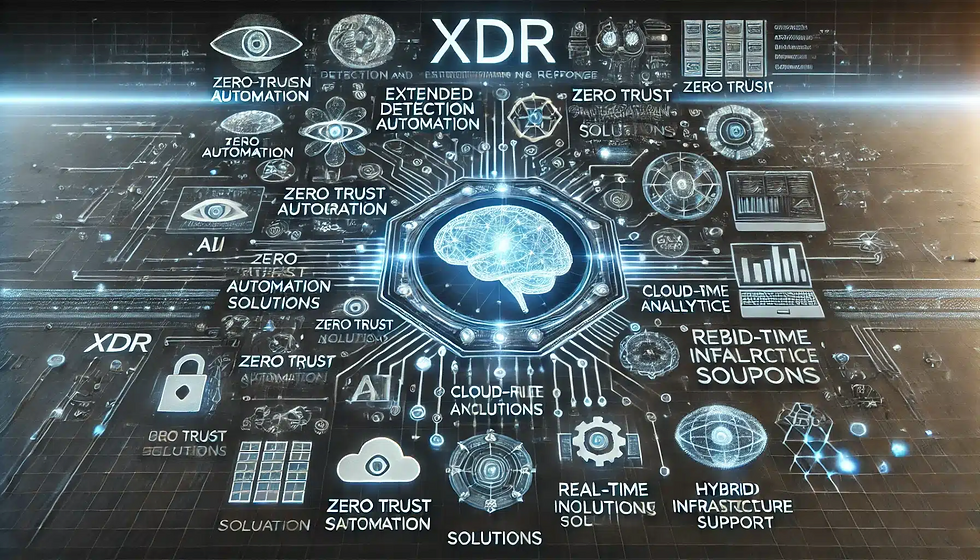Strengthening Cloud Security with XDR: A Unified Approach to Threat Detection and Response
- victorzhagui
- Feb 19
- 3 min read
Extended Detection and Response (XDR)
February 19, 2025
As businesses accelerate digital transformation and expand cloud operations, securing cloud environments against evolving cyber threats is more critical than ever. In our ongoing series on enhancing data security across cloud applications, we have explored key security frameworks such as Zero Trust Security, Cloud Security Posture Management (CSPM), Cloud Access Security Brokers (CASB), Cloud Workload Protection Platforms (CWPP), Cloud-Native Application Protection Platforms (CNAPP), and Cloud Detection and Response (CDR) solutions.
Today, we turn our focus to Extended Detection and Response (XDR)—a security approach designed to provide comprehensive visibility, real-time threat detection, and automated response capabilities across cloud and on-premises environments.
What is XDR?
Extended Detection and Response (XDR) is an advanced security solution that integrates multiple security layers—including endpoints, networks, cloud workloads, and applications—into a unified threat detection and response platform. Unlike traditional Security Information and Event Management (SIEM) or Endpoint Detection and Response (EDR) solutions, XDR breaks down security silos, allowing organizations to detect, investigate, and respond to threats more efficiently.
How XDR Enhances Cloud Security
1. Unified Visibility Across Cloud and On-Premises Environments
One of the biggest challenges businesses face is the lack of comprehensive visibility across their cloud and on-premises assets. XDR centralizes security data from various sources, giving security teams a holistic view of potential threats and vulnerabilities.
2. AI-Powered Threat Detection and Correlation
With AI-driven analytics and machine learning, XDR can detect sophisticated cyber threats in real-time by correlating security signals across different environments. This capability helps reduce false positives and ensures rapid response to actual threats.
3. Automated Incident Response and Mitigation
Speed is critical in cybersecurity. XDR automates response actions—such as isolating compromised workloads, blocking malicious activities, and triggering remediation workflows—helping organizations contain threats before they escalate.
4. Enhanced Compliance and Risk Management
For industries with strict regulatory requirements, XDR provides advanced compliance reporting and risk assessment capabilities. By continuously monitoring security posture and generating audit-ready reports, businesses can meet compliance standards more effectively.
Leading XDR Solutions in the Market
As the demand for XDR solutions grows, several industry leaders have developed robust platforms to enhance cybersecurity across cloud and hybrid environments. Here are some of the top XDR solutions available today:
1. Microsoft Defender XDR
Microsoft Defender XDR offers end-to-end security integration across Microsoft 365, Azure, and third-party security tools. With AI-powered threat intelligence and automated response capabilities, it is a strong choice for organizations using Microsoft’s ecosystem.
2. Palo Alto Networks Cortex XDR
Cortex XDR provides behavior-based threat detection and response, leveraging machine learning to detect and mitigate sophisticated attacks across endpoints, networks, and cloud environments.
3. Trend Micro Vision One XDR
Trend Micro’s XDR solution integrates with email, endpoints, servers, cloud workloads, and networks, providing a unified security approach with powerful AI-driven analytics and incident correlation.
4. SentinelOne Singularity XDR
SentinelOne’s AI-driven autonomous response capabilities make it a top choice for organizations that need to automate threat hunting, perform forensic analysis, and rapidly contain cyber threats.
5. CrowdStrike Falcon XDR
Built on the powerful CrowdStrike Falcon platform, this XDR solution enhances endpoint security by correlating data from various security sources to detect advanced persistent threats (APTs) and ransomware attacks.
6. IBM Security QRadar XDR
IBM’s AI-powered threat detection and security orchestration capabilities provide deep visibility across hybrid cloud environments, integrating seamlessly with Security Operations Center (SOC) workflows.
Each solution offers unique features tailored to different business needs, making it crucial for organizations to choose an XDR platform that aligns with their infrastructure, compliance requirements, and cybersecurity strategy.
Why Boutique IT Consulting Firms Matter
Implementing XDR and integrating it into an organization’s existing security framework can be complex. This is where boutique IT consulting firms like EZ Solution Int. add value. Our expertise in cloud security, risk management, and digital transformation enables businesses to design and deploy tailored security strategies that align with their operational needs and compliance requirements.
Looking Ahead: The Future of Cloud Security
As cyber threats continue to evolve, businesses must take proactive security measures to stay ahead. In our next post, we’ll explore the role of the Security Service Edge (SSE) in securing cloud access and remote workforces. Stay tuned as we navigate the ever-changing cloud security landscape!




Comments